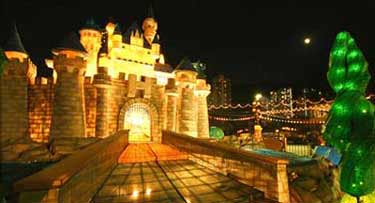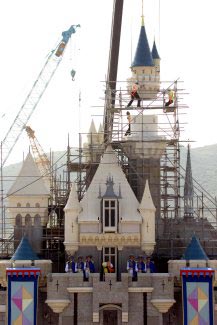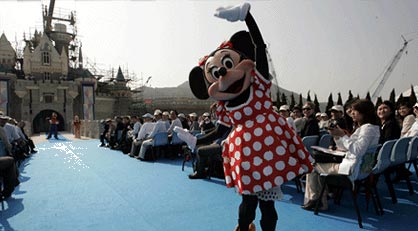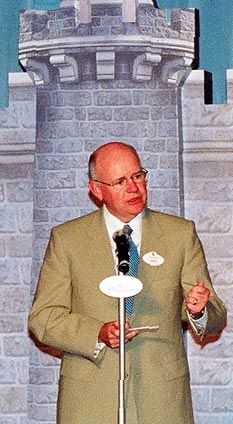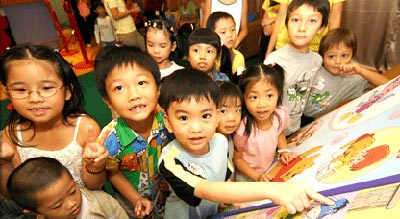|
Week of October 10, 2004 Snapshot from the Field |
LOOKING FOR A PREVIOUS STORY? CHECK THE
ARCHIVE.
Hong Kong Disneyland
Tops Out Centerpiece Structure by JACK LYNE,Site Selection Executive Editor of Interactive Publishing
"We also are extremely excited to partner with the people and government of Hong Kong to build this Disney family destination," continued Robinson, flanked on stage by company officials and costumed Disney characters including Mickey and Minnie Mouse, Donald Duck, Goofy, and Chip and Dale. "Together we will help drive job creation, tourism and economic growth, while creating a magical journey for Hong Kong."
SAR Predicting $19-Billion
Job creation, tourism and economic growth
were exactly what the SAR government had in mind in December of 1999,
when it entered into the joint venture, known as Hong
Kong International Theme Parks. At that point, Asia’s sharp
downturn had sent Hong Kong’s economy spinning into its 15th straight
month of recession. Tourism had similarly headed south. But the Disney-SAR
partnership was sealed only after more than a year of drawn-out discussions.
Boost for Hong Kong Economy "The negotiation at times has been difficult because both parties want a good deal," SAR Chief Executive Tung Chee-hwa explained after the pact was finally hammered out. But Hong Kong, some project critics continue to argue, didn’t really get a good deal. The SAR is bankrolling almost all project costs, including the estimated $1.81 billion it will take to build the park. Hong Kong also agreed to pony up $1.74 billion more to buy and develop the site at Penny’s Bay on Lantau Island.
"We think it is a pretty good return, representing eight times the original investment that has been made," Tung said.
Disney: Help Wanted
Five thousand temporary jobs are already
in place, building the park. Disney, too, has started hiring. The company
is now interviewing for 750 jobs. Five hundred of those positions are
for the first "cast members" — Disney-speak for park employees. By the
time Hong Kong Disneyland opens, it will have 5,000 cast members. The Hong Kong park’s opening date, though, is still up in the air. With the topping off of Sleeping Beauty Castle, the park is now 60 percent finished. Disney officials are saying only that Phase I of the project is on schedule to open sometime between late 2005 and early 2006. The company is reportedly consulting with local geomancers on the opening date. Dating back at least as far
Those geomancers just may decide that the optimal opening date is in October. That happens to be when the company is wrapping up its 50th- anniversary celebration of the original Disneyland’s opening in Anaheim, Calif. What’s more, the company is billing Hong Kong Disneyland as "the beginning of the next 50 years" of Disney theme park history.
5.6 Million Visitors Projected
The big question after they build it, of course, is how many will come.
The SAR’s economic-benefit model is based on the park’s drawing 5.6 million
visitors in its first year of operations, with that number rising to 10 million annually
after about 15 years.
In Park’s First Year of Operations And that may be a very reachable goal. As Walt Disney Parks and Resorts President Jay Rasulo noted at the topping-out ceremony, "Hong Kong Disneyland will serve as an important gateway for bringing the magic of Disney to families across Asia." Disney’s new park, in fact, is specifically aimed at a single huge market: Asia, the world’s most populous region. A major step in that marketing strategy is planning the cuisine that the park will offer. With much of Asian culture centering around meals, the menu that Disney selects will surely be broad. Park performances will take the same multicultural approach. Shows will be done in three languages: Cantonese, the Chinese dialect most popular in Hong Kong; Mandarin, the most widely used dialect on the mainland; and English (which is widely spoken in Hong Kong). Disney is projecting that one-third of park visitors will come from mainland China, with another one-third from Hong Kong. The remaining one-third of visitors will come largely from other Asian nations. The park’s Asia-centric focus was further underscored by July’s selection of singer and actor Jacky Cheung as Hong Kong Disneyland’s official spokesperson. Cheung is almost a total unknown in the West. But Robinson described him as "a household name in Hong Kong and across Asia." The U.S.
Park Has U.S. Focus,
Some of Disney’s broad cultural focus will narrow, however, in the park’s
ambiance. The main thoroughfare, for example, will be known as "Main Street,
U.S.A."
as Well as Communist Youth League Partnership That choice of names is based on the marketing snafus that plagued Disneyland Paris’ opening. A number of European themes were incorporated into the park’s first design. But Disneyland Paris initially drew disappointingly small crowds (as well as barbs from French journalists, who called it "a cultural Chernobyl"). Disney then realized that European audiences were looking for "an American experience," as one official put it. After embracing a more Americanized theme, Disneyland Paris started drawing big European crowds Disneyland Hong Kong will also attract big wedding crowds. More than 300 couples have already signed up for in-park nuptials.  (One registrant, however,
isn’t actually a couple — not yet, at least. She’s a young woman who
almost desperately wants to be the bride in Hong Kong Disneyland’s
first marriage ceremony. But when she made her registration, she said
she didn’t have a boyfriend, Disney officials report.) (One registrant, however,
isn’t actually a couple — not yet, at least. She’s a young woman who
almost desperately wants to be the bride in Hong Kong Disneyland’s
first marriage ceremony. But when she made her registration, she said
she didn’t have a boyfriend, Disney officials report.)
Disney also seems to have broadened its own cultural perspective in dealing with China’s all-powerful central government. The company got a hard lesson in that department in 1996, when it seemed on the verge of announcing a mainland park site, most likely in Shanghai. Then, though, the U.S. firm released Kundun, a film by acclaimed director Martin Scorsese that sympathetically depicted China’s Tibetan Buddhist
This time around, the company is carefully hewing to the party line. So much so, in fact, that Disney has entered into a partnership with the Communist Youth League (CYL). With some 70 million members, the CYL offers the park a major entrée into China’s youth market. Disney is working with the organization to present activities that include storytelling, drawing and interactive games. Those sessions are often centered around Disney characters. Rasulo calls the CYL partnership "part of an overall brand-building process."
PLEASE VISIT OUR SPONSOR • CLICK ABOVE 
Site
Selection Online
| |||||||||||||||||||
